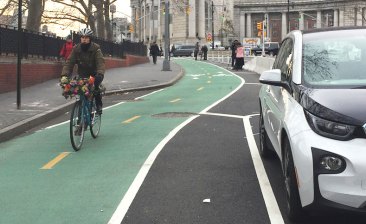Sneak Preview: The Jay Street Protected Bike Lane

Tonight, DOT will present plans for a protected bike lane on Jay Street in Downtown Brooklyn to the Brooklyn Community Board 2 transportation committee. DOT shared this rendering of the redesign with Streetsblog this afternoon.
Jay Street is an essential connection for bike commuters traveling over the Manhattan Bridge, but it’s chaos during rush hour, when cyclists must weave around a slalom course of double-parked vehicles and car and bus traffic.
Sean Quinn, DOT’s senior director for bicycle and pedestrian programs, told Streetsblog that the redesign has taken on greater urgency as the number of people biking on Jay Street has increased. DOT counts show 2,400 cyclists on the corridor in a 12-hour period. During rush hour, bikes make up 34 percent of the vehicles on Jay Street.
Once this project and its Manhattan counterpart on Chrystie Street are implemented, there will be four miles of continuous protected bike infrastructure from Midtown Manhattan to Downtown Brooklyn.
The DOT plan calls for parking-protected bike lanes on both sides of Jay Street between Sands Street and Fulton Street. For the most part, there will be five-foot bike lanes by the curb protected from motor vehicle traffic by parked cars with a two-foot painted buffer. The bikeways are narrower than typical protected bike lanes in NYC, which usually have at least a three-foot buffer and six-foot bike lane. South of Fulton, where Jay Street becomes Smith Street, there will be less protection, though we don’t have the specifics on that section yet.
DOT is working with the MTA to finalize designs for the bus stops along the route, but according to Quinn they will most likely be zones where bus and bike traffic merges. The above rendering shows the design of one particular bus stop, on the left side of the street, which is also a bus layover area.
“We had to take a lot of things into account — mainly the heavy number of buses moving north and south on the corridor,” Quinn said. “If the street was a bit wider, we could possibly have done something a little more creative with the bike lanes on one side or the other, but because of the width we have and the frequency of the buses, we came upon this design — which we think is really good — to keep the lanes clear for the majority of the corridor, moving the double-parking out of the bike facilities and accommodating bikes and buses at the bus stop locations.”
You can speak up at DOT’s presentation tonight at the CB 2 transportation committee meeting, which starts at 6 p.m. at Long Island University’s Jonas Board Room, at the corner of Flatbush and DeKalb.

